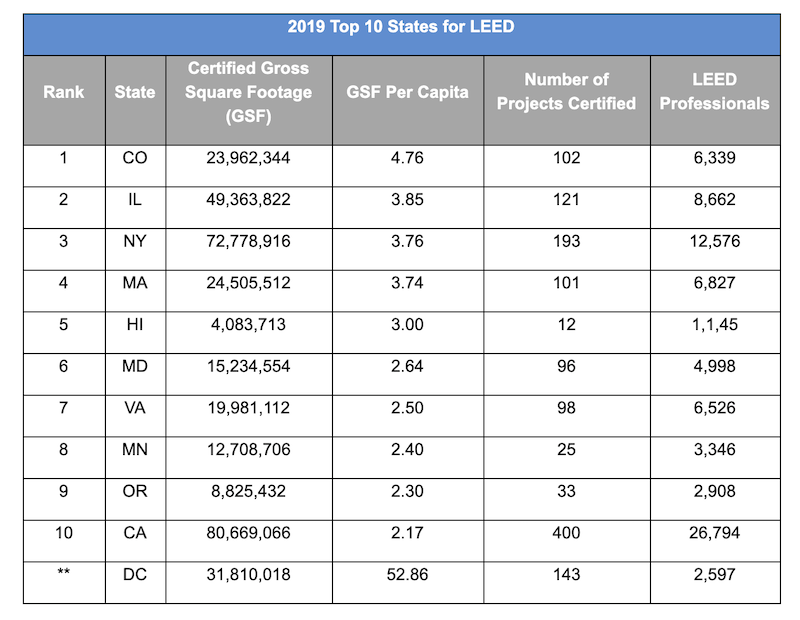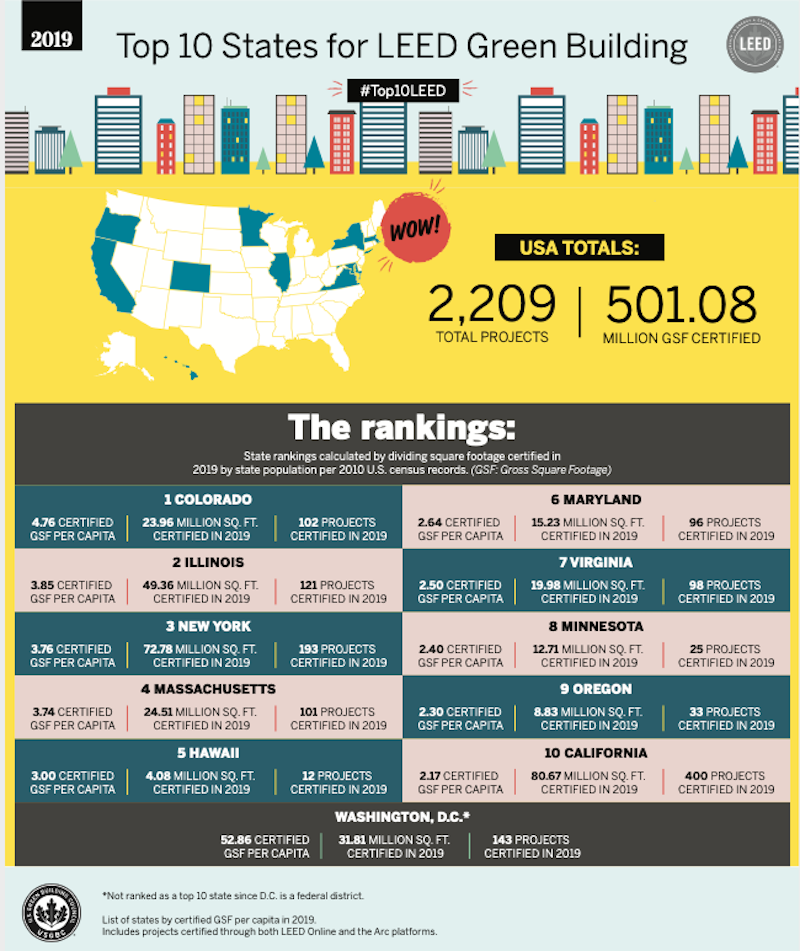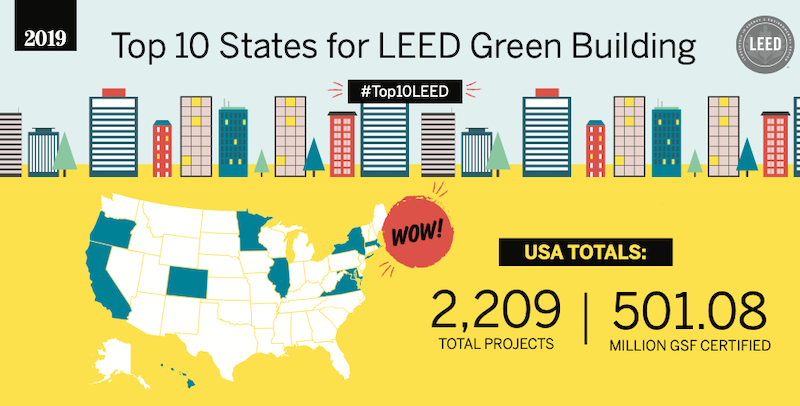As cities and states continue to work toward climate action goals, the U.S. Green Building Council (USGBC) has announced its list of Top 10 States for LEED green building. For the first time since 2011, Colorado took the top spot on the list, which ranks states based on the number of LEED certified square feet per person. LEED, or Leadership in Energy and Environmental Design, is the most widely used green building rating system in the world with more than 100,000 projects engaged. This year’s top states are home to more than 105 million people, including more than 80,000 LEED green building professionals with the skills to support the sustainable transformation of buildings.
“As we embark on a new decade, the USGBC community is focused on helping more projects get on the path to LEED certification and a more sustainable future,” said Mahesh Ramanujam, president and CEO, USGBC. “Over the last year, the Top 10 states have certified projects that serve as incredible examples of how green building can create more sustainable and resilient spaces that improve our living standard. There is still much work to be done, but the progress made across these states shows us that our work is having a tangible impact on people’s lives. As we enter our next chapter, we are committed to helping more buildings, cities and communities improve their sustainability performance through LEED.”
LEED-certified projects support personal health and well-being, as well as use less energy and water, reduce carbon emissions and save money for families, businesses and taxpayers. The Top 10 list is based on 2010 U.S. Census data and includes commercial and institutional green building projects certified throughout 2019. Colorado certified 102 green building projects representing 4.76 square feet of LEED-certified space per resident. The state has made the Top 10 list each year but jumped to the top spot after ranking sixth in 2018. Minnesota and Oregon reemerged as Top 10 states after missing the list last year, coming in at number eight and nine respectively. The full rankings are as follows:

USGBC calculates the list using per capita figures to allow for a fair comparison of the level of green building taking place among states with significant differences in population and number of overall buildings. Despite Washington, D.C. not appearing in the official Top 10 list because of its status as a federal territory, it consistently leads the nation and in 2019 certified 52.86 square feet of space per resident across 143 green building projects. The nation’s capital has a strong legacy of sustainability leadership and has expanded its use of LEED from buildings to cities and communities to support its goals. In 2017, it became the first LEED-certified city and in 2019 certified the Golden Triangle Business Improvement District LEED Platinum, the first business improvement district in the world to certify.
With green building expected to grow globally through 2021, the need for skilled professionals to support green building projects has never been more important. Across the U.S. there are more than 165,000 LEED green building professionals with the knowledge to help cities and communities transition to greener buildings and spaces. LEED professionals demonstrate a competency in green building principles that can set projects on the path to certification and help them consider ways to reduce their impact on the environment and provide people with healthier, more sustainable spaces to live, learn, work and play.

As USGBC continues to advance green buildings, cities and communities through the adoption of LEED and the latest version of the rating system, LEED v4.1, the organization is also considering a future that is focused on a more regenerative approach. In November 2019 at the annual Greenbuild International Conference & Expo, USGBC introduced LEED Positive – a roadmap that will lay the foundation for a future of LEED that transitions away from strategies that only reduce harm and instead focus on those that help repair and restore. With a continued focus on performance, USGBC is laying the groundwork to ensure sustainable design, construction and operations of buildings, cities and communities remains focused on better buildings that contribute to better lives.
Related Stories
Hotel Facilities | Aug 2, 2023
Top 5 markets for hotel construction
According to the United States Construction Pipeline Trend Report by Lodging Econometrics (LE) for Q2 2023, the five markets with the largest hotel construction pipelines are Dallas with a record-high 184 projects/21,501 rooms, Atlanta with 141 projects/17,993 rooms, Phoenix with 119 projects/16,107 rooms, Nashville with 116 projects/15,346 rooms, and Los Angeles with 112 projects/17,797 rooms.
Market Data | Aug 1, 2023
Nonresidential construction spending increases slightly in June
National nonresidential construction spending increased 0.1% in June, according to an Associated Builders and Contractors analysis of data published today by the U.S. Census Bureau. Spending is up 18% over the past 12 months. On a seasonally adjusted annualized basis, nonresidential spending totaled $1.07 trillion in June.
Hotel Facilities | Jul 27, 2023
U.S. hotel construction pipeline remains steady with 5,572 projects in the works
The hotel construction pipeline grew incrementally in Q2 2023 as developers and franchise companies push through short-term challenges while envisioning long-term prospects, according to Lodging Econometrics.
Hotel Facilities | Jul 26, 2023
Hospitality building construction costs for 2023
Data from Gordian breaks down the average cost per square foot for 15-story hotels, restaurants, fast food restaurants, and movie theaters across 10 U.S. cities: Boston, Chicago, Las Vegas, Los Angeles, Miami, New Orleans, New York, Phoenix, Seattle, and Washington, D.C.
Market Data | Jul 24, 2023
Leading economists call for 2% increase in building construction spending in 2024
Following a 19.7% surge in spending for commercial, institutional, and industrial buildings in 2023, leading construction industry economists expect spending growth to come back to earth in 2024, according to the July 2023 AIA Consensus Construction Forecast Panel.
Contractors | Jul 13, 2023
Construction input prices remain unchanged in June, inflation slowing
Construction input prices remained unchanged in June compared to the previous month, according to an Associated Builders and Contractors analysis of U.S. Bureau of Labor Statistics Producer Price Index data released today. Nonresidential construction input prices were also unchanged for the month.
Contractors | Jul 11, 2023
The average U.S. contractor has 8.9 months worth of construction work in the pipeline, as of June 2023
Associated Builders and Contractors reported that its Construction Backlog Indicator remained unchanged at 8.9 months in June 2023, according to an ABC member survey conducted June 20 to July 5. The reading is unchanged from June 2022.
Market Data | Jul 5, 2023
Nonresidential construction spending decreased in May, its first drop in nearly a year
National nonresidential construction spending decreased 0.2% in May, according to an Associated Builders and Contractors analysis of data published today by the U.S. Census Bureau. On a seasonally adjusted annualized basis, nonresidential spending totaled $1.06 trillion.
Apartments | Jun 27, 2023
Average U.S. apartment rent reached all-time high in May, at $1,716
Multifamily rents continued to increase through the first half of 2023, despite challenges for the sector and continuing economic uncertainty. But job growth has remained robust and new households keep forming, creating apartment demand and ongoing rent growth. The average U.S. apartment rent reached an all-time high of $1,716 in May.
Industry Research | Jun 15, 2023
Exurbs and emerging suburbs having fastest population growth, says Cushman & Wakefield
Recently released county and metro-level population growth data by the U.S. Census Bureau shows that the fastest growing areas are found in exurbs and emerging suburbs.

















